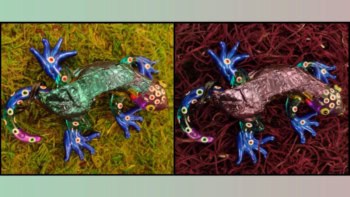
Researchers in the UK and the US have crafted an optical nanostructure that allows light to pass through without accumulating a phase change – as if the medium were completely missing in space. The device could find applications in optoelectronics, they say, for instance as a way of transporting signals without allowing information to become distorted.
Whenever light travels through a medium it experiences a phase-shift, as individual oscillations become out of phase with each other. In certain optics applications, including interferometers, these phase variations can introduce an unwanted dispersion of frequencies. This effect can lead to phase distortions, which ultimately reduce the quality of signals.
Zero-index material
But in this new study, a team led by Serdar Kocaman, an electrical engineering researcher at Columbia University, has found a way around this issue. Kokaman’s group has designed a way to control the dispersion of light by manufacturing a metamaterial that has with a refractive index of zero.
The device includes photonic crystals, which are materials with a periodic variation of the dielectric constant, resulting in a photonic band gap. Kocaman’s team fabricated photonic crystals with the unusual property of having a negative refractive index. One outcome of this optical property – not found anywhere in nature – is that the phase of light travelling through the photonic crystal flows in the opposite direction to the flow of energy.
The device consists of alternating layers, roughly 2 µm thick, of these photonic crystals along with positive index materials. The result is that the phase of light keeps oscillating but when it emerges from the device is has undergone zero overall phase change, as they explain in a research paper in Nature Photonics.
Missing space
“What we’ve seen is that the light disperses through the material as if the entire space is missing,” said Kocaman. “The oscillatory phase of the electromagnetic wave doesn’t even advance such as in a vacuum – this is what we term a zero-phase delay.”
The new device was fabricated onto a silicon chip, a few microns long. For this reason, the researchers believe that it could be integrated into optoelectronic circuits. Nicolae Panoiu, one of the researchers at University College London, told physicsworld.com that the device could be used as a “perfect mirror” for transporting optical signals within a circuit.
He says that his team has already used the optical structure to fabricate an optical filter that can be used to block photons of given frequencies. This research, he says, will be described in an upcoming paper.



